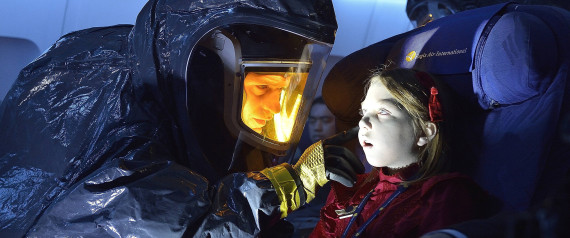
Michael Gibson/FX
Anyone who’s watched “The Strain” would agree that creator Guillermo del Toro has managed to depict and predict details from very recent public health nightmares, like last year’s Ebola crisis or the current MERS outbreak in South Korea.
The show, which debuted on FX last summer, re-imagines the vampire myth as an infectious parasite that spreads across New York after patients defy quarantine and health officials fail to recognize the threat until it’s too late.
The prescience of “The Strain” hasn’t escaped real-life public health experts: a group of scientists at the University of California, Irvine, are about to launch a free four-week online course named “Fight or Die: The Science Behind FX’s ‘The Strain.'”
In the course, experts will explore how the show’s themes and plot twists reflect core tenets within the public health and disaster preparedness community. Sarah Eichhorn, associate dean of physical sciences at UC Irvine, will be teaching a module about how such a disease could spread throughout a community as dense as Manhattan. She told The Huffington Post that the show’s terrifying depiction of a fast-spreading disease and subsequent societal collapse could “absolutely” happen.
“You see a plane land in the first episode and by the end of the first season, there’s chaos in the New York City,” Eichhorn said.
The vampire disease depicted in “The Strain” arrives when a mysterious object, a coffin filled with parasite-friendly soil that houses the master vampire, is transported on a plane and infects everyone on board. Those passengers who seem to survive the pathogen defy quarantine to go home, setting the stage for the disease to quickly takeover the metropolis.
Sound familiar? A similar situation happened just last month, when a Korean businessman traveling in Saudi Arabia returned home with Middle East Respiratory Syndrome, which can cause pneumonia, organ failure and death. He visited four health facilities before he was properly diagnosed and isolated, which spread the disease to more than 80 other people.
The son of one of the infected patients defied quarantine orders and traveled to China, where he too began exhibiting symptoms of the deadly virus. He is now in isolation.
“I think the show is very accurate in its portrayal of the challenges that the [Centers for Disease Control and Prevention] might face in trying to respond to a disease threat,” Eichhorn said. “It is an accurate [depiction] of how bad an outbreak could be.”
The course will also feature a variety of experts on topics like bioethics, cybersecurity and emergency preparedness. It will cover three basic “strains”: parasites, disease dynamics and cyber attacks. All three come into play in “The Strain,” and the group of experts teaching the course will address how the compare to real-world scenarios, as well as what individuals can do to prepare themselves against each individual threat.
Thankfully, we don’t have any fast-spreading diseases that can turn you into a vampire, but there are real-life viruses that affect behavior and patterns. For example, a startling percentage of people around the globe are infected with a scary parasite called Toxoplasma gondii, said Eichhorn. The parasite spread by infecting rats and changing their nature to make them attracted to cats, a natural predator, so that the parasite can jump species and reproduce in its preferred environment.
“That’s a really stunning biology change, much like on ‘The Strain’ where you see the vampire parasite infecting the host and making them go infect their family,” said Eichhorn.
Those who want to dig deeper into the show’s portrayal of cybersecurity, parasites and pandemics can sign up for the course on canvas.net/strainmooc. Classes start June 22. And for those who just want to feel the blood drain from their face while watching a super-graphic medical horror show, season two of “The Strain” begins July 12. Here’s a little autopsy scene to whet your appetite: